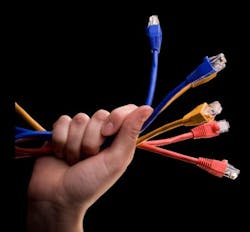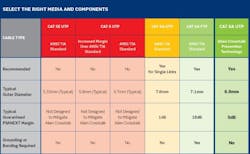By Bill Lauby and John Seger, Leviton Network Solutions
Large-format displays are changing the digital-media/digital-display landscape. Increasing display size for audiences in classrooms, hospitals, hotels, and the enterprise is driving the need for higher-resolution, moving beyond today’s high of 1080p. Ultra-high-definition video with 4K and even 8K resolution is regarded as the next standard, with 4K delivering 2160p format at 3840x2160 pixel density. Digital AV signals driving these displays will consume more and more bandwidth as resolution increases, so installing an optimal infrastructure now can eliminate issues in the near future.
HDMI cable alone is not an ideal solution for transmitting higher-resolution signals over longer distances. Long HDMI cables are heavy, inflexible, expensive and difficult to pull. Because of the large connectors, these cables are unfeasible for retrofit or upgrade projects in conduit applications.
Preterminated multi-conductor runners with active and passive wallplates, another method of AV connectivity, have many of the same issues when delivering high-resolution signals over long distances. Multi-conductor runners are also heavy and inflexible, making them difficult to deploy. They often require longer lead times, are limited by conductor size, and connectors are easily damaged.
Overall, HDMI and muli-conductor runner solutions, while good for shorter lengths, are more expensive and troublesome when used over longer distances, especially when plenum-rated cable is required. For higher resolution over longer distances, HDBaseT technology that transmits HDMI signals over category-rated cable delivers the resolution needed for the distance required while minimizing costs, maintaining reliability, and making installation fast and easy.
Why HDBaseT
HDBaseT is a technology that enables faster, simpler installations of large-format displays. This is accomplished by using a single category-rated cable to carry the high-bandwidth signals required for high-resolution displays across distances up to 100 meters (328 feet).
HDBaseT is widely becoming adopted by installers as a reliable, plug-and-play HDMI extension method. With an HDBaseT AV Signal Extender you are able to turn a tested, certified datacom permanent link/channel into an IT/AV link/channel that is more reliable, flexible, and scalable than traditional HDMI cables or multi-conductor systems. And HDBaseT allows displays to be installed using the same materials and skills currently used for a LAN infrastructure, creating big opportunities and a new source of revenue for datacom installation experts.
Choosing a category-rated cable for an IT/AV link
When planning to deploy category-rated cable for an IT/AV link, it’s important to install the most appropriately rated cable for the performance desired. The HDBaseT Alliance specification lists Category 5e and Category 6 UTP cabling as supported media types. However, recent testing by Leviton revealed that Category 6A UTP cabling is the most ideal solution to support an IT/AV link.
Leviton conducted a series of tests to verify the capability of different category channels, cable, and connector types. Testing concentrated on the effectiveness of the extenders at their maximum distance capability (shorter distances may have better performance) and was conducted using 1080p/60 video sources.
HDBaseT enables the transmission of AV signals at speeds of 10.2 Gbits/sec and a frequency of 300 MHz. TIA UTP cable specifications define the frequency capability for Category 5e at 100 MHz, Category 6 at 250 MHz, and Category 6A at 500 MHz. Prior to testing it was hypothesized Category 5e would likely fail, as its capacity is well below the 300-MHz frequency requirement. Category6 signals would also likely struggle for the same reason.
Testing with Category 5e UTP cable
While Category 5e channels can carry HDBaseT signals in a point-to-point link, they do not support HDBaseT in real-world high-density installations with adjacent data or HDBaseT channels. Using Category 5e UTP cable in these applications led to signal dropouts and total link loss, as the channels are not designed to resist alien crosstalk (signal crosstalk from one cable to another).
Victim = HDBaseT 1.0 Extension Channel 1080p/60
Disturbers = Multiple HDBaseT 1.0 Extension Channels 1080p/60
Results:
- Category 5e channels can carry HDBaseT 1.0 1080p signals in a point-to-point isolated channel
- Category 5e channels do not support HDBaseT signals in high-density installations bundled with adjacent HDBaseT channels
- When a Category 5e UTP channel is tested with one adjacent HDBaseT disturber, the HDBaseT extender attempts to connect, but never succeeds
- Category 5e channels are not designed for 300-MHz signals and are not optimized for resistance to alien crosstalk
Testing with Category 6 UTP Cable
Leviton conducted testing with two types of Category 6 cables (Cat 6 UTP cable to ANSI/TIA minimum standards and Cat 6 UTP cable with increased margin over ANSI/TIA standard). In both instances the Category 6 channels demonstrated marginal success during testing, but signal failures did occur. Category 6 UTP cables can be limited in carrying signals when adjacent to other cables carrying HDBaseT signals and, like Category 5e UPT cable, Category 6 UTP cable is not designed to support 300 MHz or capable of effectively resisting alien crosstalk.
Test Configuration B—100m Category 6 UTP Cable (6-around-1 bundle)
Category 6 UTP cable to ANSI/TIA standard
Category 6 UTP cable with increased margin over ANSI/TIA standard
Victim = HDBaseT 1.0 Extension Channel 1080p/60
Disturbers = Multiple HDBaseT 1.0 Extension Channels 1080p/60
Results:
- Even Category 6 UTP cable with increased margin over the ANSI/TIA standard is limited in carrying HDBaseT 1.0 signals when adjacent to other cables carrying HDBaseT signals
- Category 6 channels are not designed for 300-MHz signals and are not optimized for resistance to alien crosstalk
Testing with Category 6A UTP and FTP cable
Leviton conducted testing with three types of Category 6A cable (Category 6A UTP cable to ANSI/TIA minimum standards, Category 6A UTP cable with alien crosstalk prevention technology, and Category 6A FTP cable). In this phase of testing, Category 6A cable was the only category rating to consistently support HDBaseT signals in the presence of multiple disturbers, including other HDBaseT signals and 10 GbE. And while errors were present when tested with an HDMI tester, no obvious video dropout occurred.
Test Configuration C—100m Category 6A Cable (6-around-1 bundle)
Category 6A UTP cable to ANSI/TIA standard
Category 6A UTP cable with alien crosstalk prevention technology
Category 6A FTP cable
Victim = HDBaseT 1.0 Extension Channel 1080p/60
Disturbers = Multiple HDBaseT 1.0 Extension Channels 1080p/60 + (2) 10GBaseT Ethernet channels
Results:
- Category 6A UTP channels support HDBaseT 1.0 1080p signals in the presence of multiple disturbers, including other HDBaseT and 10-Gbit Ethernet
- Errors occur in standard Category 6A UTP channels when tested with an HDMI tester, but there is no obvious video dropout
- Category 6A UTP cable with alien crosstalk prevention technology exhibited 0 errors
- Category 6A FTP cable exhibited 0 errors
Results Summary
Testing confirmed Category 5e UTP cable is unable to provide the reliability desired for IT/AV signals over long distances, and in most cases it did not support the signal at all. Category 6 UTP cable came close to meeting signal requirements and delivered modest performance, but issues with alien crosstalk raise concerns regarding reliable signal integrity. Across the board, Category 6A cable delivered the level of signal required for higher resolution over long distances. However, cable with alien crosstalk prevention technology is recommended.
Alien Crosstalk Prevention Technology in an IT/AV Link
While Category 6A cable was the only category rating to consistently deliver reliable signal performance over long distances, Category 6A solutions capable of mitigating alien crosstalk provided top-tier performance throughout all phases of testing.
Alien crosstalk may not be an issue within individual classrooms, conference rooms, lecture halls, or other facilities that benefit from longer-distance IT/AV signals. However, applications and pathways where multiple cables are bundled together generate enough alien crosstalk from 10GBaseT or other HDBaseT signals to cause significant signal interference. For this reason a Category 6A UTP solution with alien crosstalk prevention technology is ideal.
Category 6A UTP with Alien Crosstalk Prevention Technology vs. Category 6A FTP Cable
FTP cable works to prevent alien crosstalk in two ways.
- By creating a barrier between pairs in adjacent cable where the inherently “open” structure of the twisted pairs allows magnetic fields to escape. The magnetic field sets up eddy currents in the barrier, which then creates a magnetic counter field, preventing magnetic coupling from one pair to the other.
- By creating an electrostatic barrier over multiple pair twists in order to create a “zero-average” voltage potential without peaks that can also couple to an adjacent pair in an adjacent cable.
When low (100s) MHz to GHz frequencies are required, like those needed for an HDBaseT signal, the actual grounding of the shield Is not relevant. However, failing to do so creates the potential for setting up resonances that will cause alien crosstalk or other signal degradation. At high frequencies, the important function of the shield is to perform the two aforementioned barrier tasks.
Due to the point-to-point nature of typical HDBaseT applications, it is not possible to follow TIA-568 or TIA-607 bonding and grounding standards. Most HDBaseT products utilize a power supply or PoE with no ground connection. Using shielded channels on a point-to-point application with no connection in a telecommunications room (TR) will result in a floating round in many cases. This adds electromagnetic interference (EMI) risk and should be avoided.
Alien crosstalk prevention technology takes advantage of the phenomenon that the shield can be discontinuous and the length of the shield segment can be adjusted to cover only a few twists, establishing eddy currents and the magnetic counter field, and also creating a capacitive effect sufficient to prevent alien crosstalk.
Leviton has developed a patented technology that tunes the length and shape of the shielded sections to perform best in the desired frequency range for category-rated cables. This innovative solution installs as easily as standard UTP cable. Because alien crosstalk prevention technology does not require grounding or bonding, you get the benefits of a shielded cable without any of the installation headaches or costs.
During testing, the Leviton Atlas-X1 Category 6A UTP system, featuring cable with alien crosstalk prevention technology, outperformed any other Category 6A UTP solution. The Atlas-X1 Category 6A UTP system offers the smallest outside diameter (OD), eliminates alien crosstalk without the need for grounding or bonding, supports familiar installation and termination practices, and is capable of delivering the greater signal bandwidth needed for emerging IT/AV technologies.
With the increasing demand for ultra-high-definition video displays, it is important to install an optimal infrastructure now that will meet IT/AV network requirements and eliminate potential issues in the future. 4K resolution delivering 2160p format at 3840x2160 pixel density is readily available. To avoid dropouts or link loss at that resolution while mitigating issues caused by alien crosstalk, a Category 6A UTP channel with alien crosstalk prevention technology cable is highly recommended. No other UTP cable option reliably supports AV signal integrity over long distances while eliminating the installation headaches associated with FTP cable, making it the best solution capable of meeting IT/AV technology demands.
You can learn more about Leviton HDBaseT solutions at Leviton.com/ITAV.
Bill Lauby is senior product manager and John Seger is principal technical specialist with Leviton Network Solutions.





